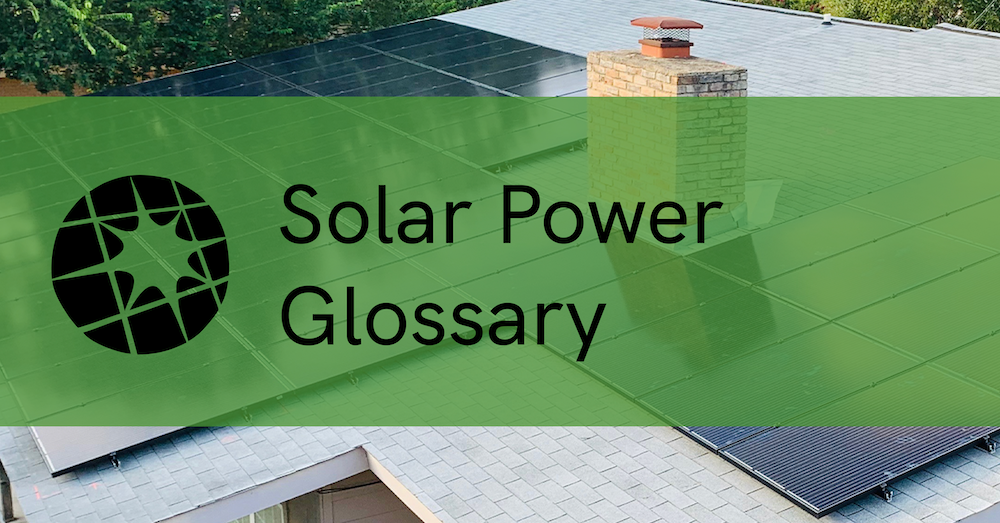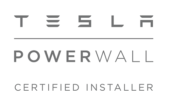If you’re looking into installing solar, you’ve probably come across many different solar energy terms and industry buzzwords. While some solar terminology will make perfect sense to you if you have a background in engineering or electronics, most people see solar terms as complicated and impossible to understand.
At Wells Solar, we’re all about educating you on the benefits of installing solar. A big part of that is actually understanding how your solar panel system works. Our team of energy consultants can always help answer any questions you have, but this long list of solar energy terms and definitions should get you started!
Solar Power Terminology
- Alternating current (AC): A type of electrical current, the direction of which is reversed at regular intervals or cycles. In the United States, the standard is 120 reversals or 60 cycles per second. Electricity transmission networks use AC because voltage can be controlled with relative ease.
- Angle of Incidence: The angle that a ray of sun makes with a line perpendicular to the surface. For example, a surface that directly faces the sun has a solar angle of incidence of zero, but if the surface is parallel to the sun (for example, sunrise striking a horizontal rooftop), the angle of incidence is 90°.
- Array: A solar array is a collection of solar panels wired together to create the desired energy output. The typical residential solar array consists of 20–25 solar panels to cover 100% of its energy consumption.
- Azimuth: The direction that your roof faces (in the context of solar). The azimuth is measured in degrees, representing the angle between your roof and true north.
- Bypass diode: A diode connected across one or more solar cells in a photovoltaic module such that the diode will conduct if the cell(s) become reverse biased. It protects these solar cells from thermal destruction in case of total or partial shading of individual solar cells while other cells are exposed to full light.
- Cells: The smallest semiconductor element within a PV module to perform the immediate conversion of light into electrical energy (direct current voltage and current). Also called a solar cell.
- Conductor: The material through which electricity is transmitted, such as an electrical wire, or transmission or distribution line.
- Direct current (DC): A type of electricity transmission and distribution by which electricity flows in one direction through the conductor, usually relatively low voltage and high current. To be used for typical 120 volt or 220 volt household appliances, DC must be converted to alternating current, its opposite.
- Disconnect: Switch gear used to connect or disconnect components in a photovoltaic system.
- Electrical grid: An integrated system of electricity distribution, usually covering a large area.
- Electrode: A conductor that is brought in conducting contact with a ground.
- Fixed tilt array: A photovoltaic array set in at a fixed angle with respect to horizontal.
- Gigawatt (GW): A unit of power equal to 1 billion Watts; 1 million kilowatts, or 1,000 megawatts.
- Grid-tied System: A solar electric or photovoltaic (PV) system in which the PV array acts like a central generating plant, supplying power to the grid.
- Interconnection: Interconnection is what allows power to be transmitted between two parties—a utility provider and an end-user, for instance, or two separate utility companies. Linked transmission lines let power move back and forth in either direction. In relation to renewable power specifically, interconnection refers to the process of connecting renewable technologies to the larger electrical grid.
- Inverter: A solar inverter converts direct current (DC) power to alternating current (AC) electricity, either for individual solar panels or for grid-connected solar power systems. DC power produced by a solar array must be converted to AC electricity so it can be used in household appliances — without an inverter, the energy from your solar panels cannot easily be put to use. There are three basic types of inverters: microinverters, string inverters, and central inverters.
- Junction box: A photovoltaic (PV) generator junction box is an enclosure on the module where PV strings are electrically connected and where protection devices can be located, if necessary.
- Junction diode: A semiconductor device with a junction and a built-in potential that passes current better in one direction than the other. All solar cells are junction diodes.
- Kilowatt (kW): A standard unit of electrical power equal to 1000 watts, or to the energy consumption at a rate of 1000 joules per second.
- Kilowatt-hour (kWh): 1,000 thousand watts acting over a period of 1 hour. The kWh is a unit of energy. 1 kWh=3600 kJ.
- Load: The demand on an energy producing system; the energy consumption or requirement of a piece or group of equipment. Usually expressed in terms of amperes or watts in reference to electricity.
- Megawatt (Mw): 1,000 kilowatts, or 1 million watts; standard measure of electric power plant generating capacity.
- Megawatt-hour: 1,000 kilowatt-hours or 1 million watt-hours.
- Meter: This is what monitors the energy production of your home solar system. You’re probably familiar with the traditional meter, but if you get solar panels, you’ll need a bi-directional or digital meter.
- Module: Also called solar panels, a solar module is a single photovoltaic panel that is an assembly of connected solar cells. The solar cells absorb sunlight as a source of energy to generate electricity. An array of modules are used to supply power to buildings.
- Multicrystalline: A semiconductor (photovoltaic) material composed of variously oriented, small, individual crystals. Sometimes referred to as polycrystalline or semicrystalline.
- Orientation: Placement with respect to the cardinal directions, N, S, E, W; azimuth is the measure of orientation from north.
- Panel: When solar cells are wired together to generate larger amounts of power — typically in a bundle of 36-40 cells — they form a solar panel. The term solar panel is often used interchangeably with solar panel. To accomplish desired current and voltage, solar panels are wired together to form an array.
- Peak Demand: The maximum energy demand or load in a specified time period.
- Peak Sun Hours: Not to be confused with an hour of daylight, one peak sun hour is one hour’s worth of sunshine at an irradiance of 1 kilowatt per square meter (kW/m2). Peak sun hours, measured as kilowatt-hours per square meter (kWh/m2), are influenced by the time of day, the season, the presence of clouds, and geographic location. Even though solar panels may receive eight hours of partial sunlight in a given day, that may average out to only three or four peak sun hours.
- Photon: A particle of light that acts as an individual unit of energy.
- Photovoltaic (PV): Pertaining to the direct conversion of light into electricity.
- Polycrystalline silicon: A material used to make photovoltaic cells, which consist of many crystals unlike single-crystal silicon.
- Power rating: Represents the theoretical power output of a solar panel in ideal conditions. While power rating is a good indicator of quality, most solar panels don’t experience ideal conditions for more than a few moments.
- Solar energy: Electromagnetic energy transmitted from the sun (solar radiation). The amount that reaches the earth is equal to one billionth of total solar energy generated, or the equivalent of about 420 trillion kilowatt-hours.
- Solar panel efficiency: Represents how well a solar panel converts sunlight into electricity. Most solar panels have 14 to 16 percent efficiency; high-efficiency panels are rated just above 20 percent.
- String: A number of photovoltaic modules or panels interconnected electrically in series to produce the operating voltage required by the load.
- System availability: The percentage of time (usually expressed in hours per year) when a photovoltaic system will be able to fully meet the load demand.
- Temperature coefficient: Represents how well a solar panel can perform in high-heat conditions. As with all electronics, high heat can negatively affect solar panel performance.
- Thin film: A layer of semiconductor material, such as copper indium diselenide or gallium arsenide, a few microns or less in thickness, used to make photovoltaic cells.
- Tilt angle: The angle at which a photovoltaic array is set to face the sun relative to a horizontal position. The tilt angle can be set or adjusted to maximize seasonal or annual energy collection.
- Tracking array: A photovoltaic (PV) array that follows the path of the sun to maximize the solar radiation incident on the PV surface. The two most common orientations are (1) one axis where the array tracks the sun east to west and (2) two-axis tracking where the array points directly at the sun at all times. Tracking arrays use both the direct and diffuse sunlight. Two-axis tracking arrays capture the maximum possible daily energy.
- Transformer: An electromagnetic device that changes the voltage of alternating current electricity.
- Watt: The rate of energy transfer equivalent to one ampere under an electrical pressure of one volt. One watt equals 1/746 horsepower, or one joule per second. It is the product of voltage and current (amperage).
- Waveform: The shape of the phase power at a certain frequency and amplitude.
Solar Battery Terminology
- Battery energy storage: Energy storage using electrochemical batteries. The three main applications for battery energy storage systems include spinning reserve at generating stations, load leveling at substations, and peak shaving on the customer side of the meter.
- Battery capacity: The maximum total electrical charge, expressed in ampere-hours, which a battery can deliver to a load under a specific set of conditions.
- Cycle: The discharge and subsequent charge of a battery.
- Multi-stage controller: A charging controller unit that allows different charging currents as the battery nears full.
- Series regulator: Type of battery charge regulator where the charging current is controlled by a switch connected in series with the photovoltaic module or array.
Storage battery: A device capable of transforming energy from electric to chemical form and vice versa. The reactions are almost completely reversible. During discharge, chemical energy is converted to electric energy and is consumed in an external circuit or apparatus.
Solar Energy Pricing, Incentive, & Financing Terms
- Annual Solar Savings: The annual solar savings of a solar building is the energy savings attributable to a solar feature relative to the energy requirements of a non-solar building.
- Community Solar: A solar power plant whose electricity is shared by more than one household. Often framed as an alternative to rooftop solar. Also known as a solar garden or shared renewable energy plant.
- Federal investment tax credit (ITC): Commonly referred to as the federal solar tax credit, the ITC effectively reduces the total cost of your solar energy system by 26 percent with a credit to your federal taxes. It is regarded as the most significant financial incentive for solar in the U.S.
- Net metering: A practice that credits you for the excess electricity generated by your solar panels, which you can then draw upon when your panels don’t produce enough electricity to match your use. With net metering, you effectively use the electric grid to “store” excess electricity for later use.
- Grid parity: The point at which power generated by solar panels costs the same or less than power from conventional resources like natural gas. Solar is already at grid parity in 20 states.
- Levelized cost of energy (LCOE): The per-unit cost of energy from a solar energy system. LCOE is calculated by dividing the out-of-pocket cost for the system by the estimated total amount of energy the system will produce over its lifetime.
- Payback period: Represents how long it takes to “breakeven” on a solar energy investment. The average payback period for solar homeowners in the U.S. is just over seven years. In the long run, it’s typically going o be more expensive for you not to go solar.
- Power purchase agreement (PPA): Contract with a solar company to have a solar energy system installed on your roof. With a solar PPA, you agree to pay the company a per kilowatt-hour rate for the electricity produced by the solar panels.
- Solar lease: Contract with a solar company to have a solar energy system installed on your roof. With a solar lease, you agree to pay the company a fixed monthly fee to “rent” the system in exchange for the benefits (i.e., the electricity) the system provides.
- Solar loan: A loan provided by a bank, credit union, or specialty provider to finance the cost of buying a solar PV system.
- Solar renewable energy credit (SREC): For every unit of electricity that a solar panel system generates, an associated SREC is also created. In some states, you can sell your SRECs for additional revenue.
Other Solar Energy Terms
- Energy audit: A survey that shows how much energy used in a home, which helps find ways to use less energy.
- EPC: Engineering, Procurement and Construction” (EPC) is a particular form of contracting arrangement used in some industries where the EPC Contractor is made responsible for all the activities from design, procurement, construction, to commissioning and handover of the project to the End-User or Owner.
- Irradiance: Irradiance is the amount of power received per a specific area. Solar irradiance measures all radiation from the sun that strikes a particular surface, whether it’s direct or reflected. Irradiance is typically demonstrated in kilowatts per square meter (kW/m2).
- National Electrical Code (NEC): The NEC, also known as NFPA 70, is a publication from the National Fire Protection Association that provides guidelines for all manner of electrical installation in the United States. Article 690, which details specific installation codes for solar photovoltaic (PV) systems, should be consulted for all PV System installations. Local and state guidelines may qualify some NEC suggestions and should also be considered prior to installation of any solar energy system.
- Sine wave: A waveform corresponding to a single-frequency periodic oscillation that can be mathematically represented as a function of amplitude versus angle in which the value of the curve at any point is equal to the sine of that angle.
- Sine wave inverter: An inverter that produces utility-quality, sine wave power forms.
- Smart grid: Smart grids are electrical grids that incorporate digital technology, allowing for computer-based automation, remote control, and two-way communication between a utility and its customers. Because smart grids consist of technology and equipment working together, they can respond digitally to immediate changes in demand for electricity. Smart grids should offer increased energy efficiency both on the grid and in end-users’ homes and offices.










